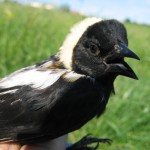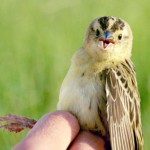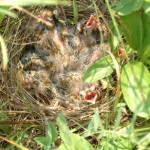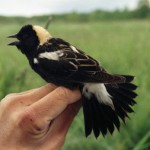
Male Bobolink in the hand. Photo by Noah Perlut.
Each summer aerial dramas help define the sights and sounds of New England’s agricultural landscape. Male bobolinks, jet black with a bright yellow nape and white tuxedo-like markings on their backs, soar into the air singing so wildly they almost seem confused and then land like butterflies on the tall grass. Female bobolinks, golden and bronze, sleek, with delicate stripes on top of their heads, like to test their mates and neighbors, making a whine-like call and rocketing into the sky to see which male can keep pace.
Unfortunately, these dramas are acted out less and less each summer. According to the Breeding Bird Survey, if Maine had 100,000 breeding Bobolinks in 1966, by 2007 there were slightly less than 60,000 (-1.25% annual decline). Two factors explain these declines. First, the total amount of grassland habitat has declined. In 2007 Maine had 197,757 acres of managed grassland (14,432 acres in York Country), a 50% decline from 1987.
Despite this decline, the state still has suitable, albeit reduced, habitat for grassland songbirds, mainly those lands owned by private individuals. The second cause of decline is linked to increasing intensity of management, where farmers cut hay earlier and more frequently through the season. Such increase is advantageous because forage harvested earlier in the season has greater nutrition, which leads to greater milk production in dairy cows.
I have studied the effects of increased management intensity on Bobolinks, Savannah Sparrows and Eastern Meadowlarks in Vermont for the last nine years. The big picture of this work is clear: as intensity of management increases, birds’ reproductive success and their probability of surviving to the next year decreases. For example, a female Bobolink breeding on a hayfield cut in late-May and again in early-July has zero reproductive success. Meanwhile a female breeding in a field cut on August 1 will successfully produce at least three young.
Can both intensive hay-farmers and birds co-exist? Yes! Vermont’s National Resource Conservation Service (NRCS) recently created an incentive payment for intensively managed hayfields. Farmers are encouraged to cut as early as possible (must be before 31 May) and then delay their second harvest for 65 days (compared to the typical 35-40 day delay). In return farmers receive $135 per acre. This modest change in the timing of haying increased the average Bobolink reproductive success from zero to three offspring per year.
An open dialog between farmers, conservationists, agencies and researchers developed a mutually satisfying management plan in Vermont, and a Maine-specific model can be created too. The Bobolink’s future in Maine will indeed be determined by the management decisions of each individual landowner.
Noah Perlut is an Assistant Professor in the Department of Environmental Studies at the University of New England
Read an article about Dr. Perlut’s work in the Burlington Free Press.
-

-
Male Bobolink. Photo by Noah Perlut.
-

-
Female Bobolink. Photo by Noah Perlut.
-

-
Young Bobolinks in the nest. Photo by Noah Perlut.
-

-
Male Bobolink in the hand. Photo by Noah Perlut.








